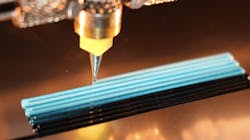3D Printing Shields Satellite Components
MIT Lincoln Laboratory’s Advanced Materials and Microsystems Group has developed an approach for a three-dimensional (3D) printing process to shield satellite components from the ills of radiation exposure. The conceptual process prints conformal shielding on discrete components and ICs, transforming commercial-off-the-shelf (COTS) parts to radiation-hardened (rad-hard) devices suitable for satellite use. The approach fabricates conformal shielding on the components, rather than adding traditional shields with much larger size and weight.
Bradley Duncan, a technical staff member with the Advanced Materials and Microsystems Group and lead investigator for the research, said, “This program, if successful, will allow the U.S. Department of Defense to use virtually all integrated-circuit technologies in extreme radiation environments, such as space, by shielding commercially available electronics from destructive radiation.”
The novel shielding approach employs a custom, active mixing nozzle (see the figure) developed by MIT Lincoln Laboratory. The tool deposits shielding materials directly on components, such as ICs, to protect them from the effects of radiation in space. A robotically controlled print head substitutes a paste-like shielding material for ink, spreading it conformally around a component to achieve a required level of shielding without undue changes in component size and weight. Self-supporting filaments built from the 3D-printing nozzle form the shielding.
Devon Beck, an associate staff member in the same group working on the 3D-printing project, said, “By printing custom shield architectures directly onto electronics, we can potentially enable the most advanced commercial off-the-shelf electronics to exist in space environments.”
The MIT research is driven by the need to miniaturize components as part of efforts to reduce component size, weight, and power (SWaP) for various satellite systems, such as communications and surveillance satellites. Pascale Gouker, a senior staff member in the MIT group, added, “3D-printed shielding will be a disruptive innovative approach to producing high-performance radiation-hardened microsystems.”
About the Author
Jack Browne
Technical Contributor
Jack Browne, Technical Contributor, has worked in technical publishing for over 30 years. He managed the content and production of three technical journals while at the American Institute of Physics, including Medical Physics and the Journal of Vacuum Science & Technology. He has been a Publisher and Editor for Penton Media, started the firm’s Wireless Symposium & Exhibition trade show in 1993, and currently serves as Technical Contributor for that company's Microwaves & RF magazine. Browne, who holds a BS in Mathematics from City College of New York and BA degrees in English and Philosophy from Fordham University, is a member of the IEEE.
